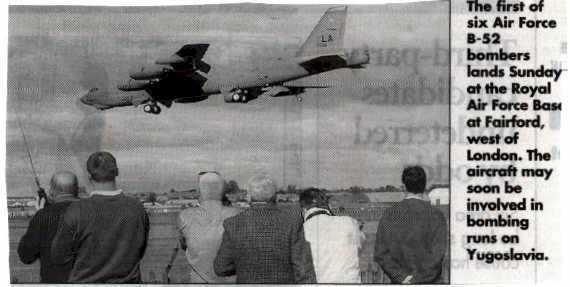
CLICK HERE TO PLAY & DOWNLOAD COMREV MUSIC -3mb
VIOLATIONS OF THE SECURITY COUNCIL RESOLUTION 1244 (1999)
YUGOSLAVIA SITES ACCESS
Akademski Informacioni Centar Srbije
FEDERAL MINISTRY OF FOREIGN AFFAIRS
RTV BK Telecom - Agresija NATO - vanredno izdanje www.bktv.com
Cluster Bomb Pictures (Fotografije)
A U$ Bombing of Yugosalvia Pic Page (Fotografije)
Destructions in Kraljevo and surroundings
Great Yugoslavian Audio/VideoArchive Site
URL/Email/U$ Media Addresses (Vesti)
YuSky - Yugoslav Internet Information Service
NATO attacks civilian targets!!!!!!!
FEDERAL MINISTRY OF FOREIGN AFFAIRS OF THE FR OF YUGOSLAVIA
Aircraft used and lost in Yugoslavia during NATO aggr
Belgrade Academic Association For Equal Rights In The World

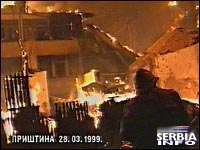

Civilian Buildings In Flames
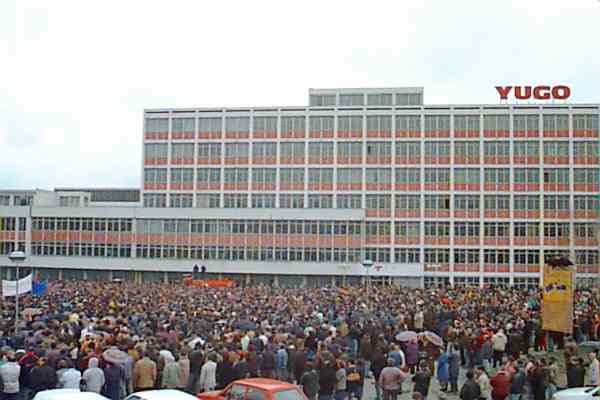
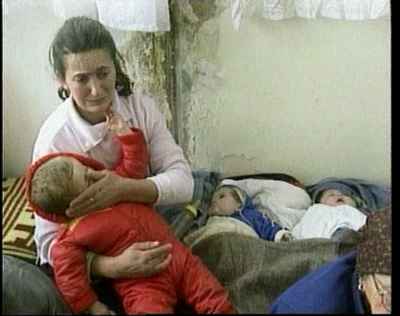
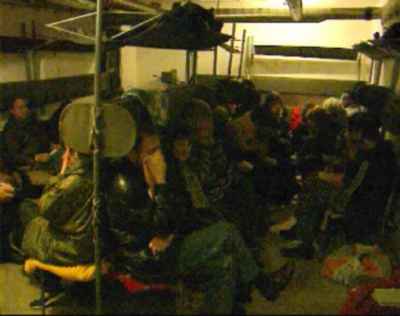
Not Enough Gas Masks, Blood Transfusion Equipment, Etc.
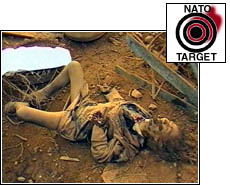
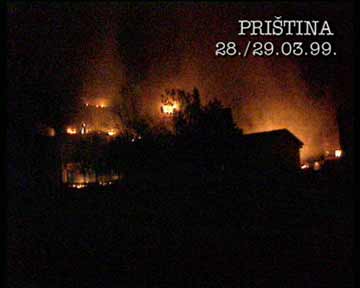
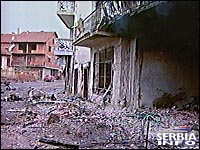
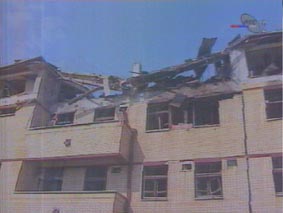
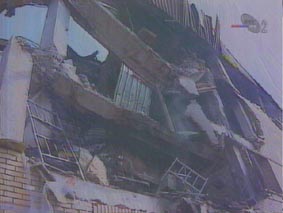
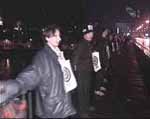
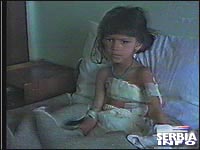
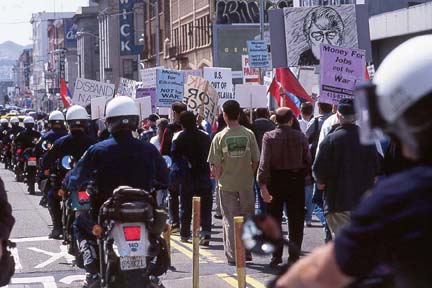
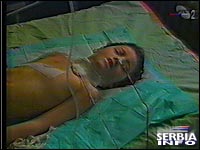
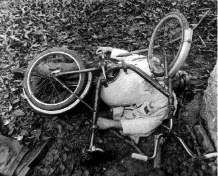
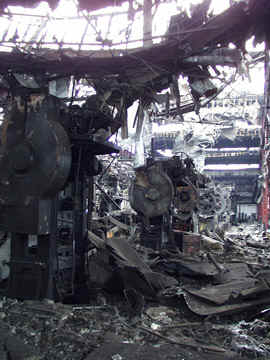 YUGO PLANT
YUGO PLANT
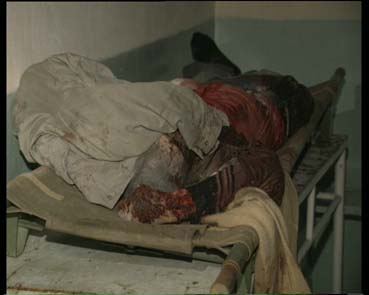
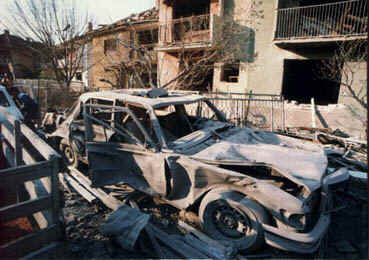
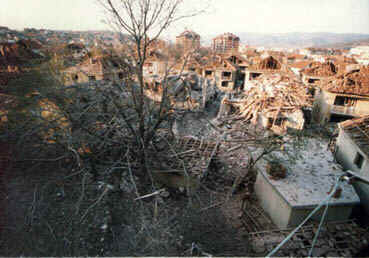
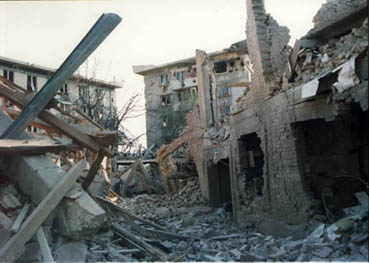
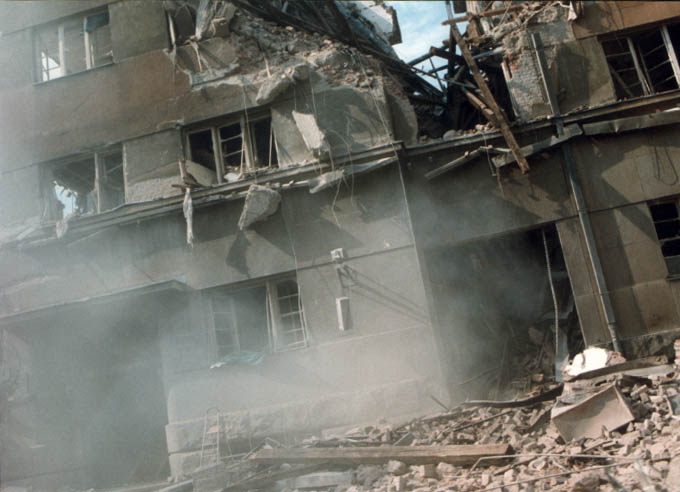

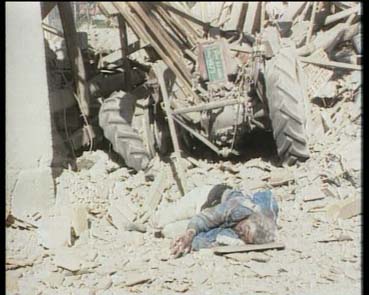
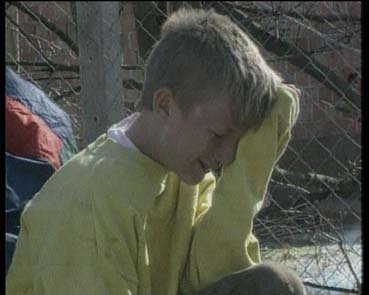
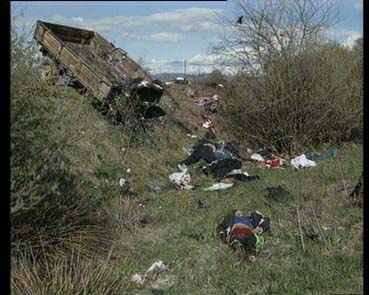
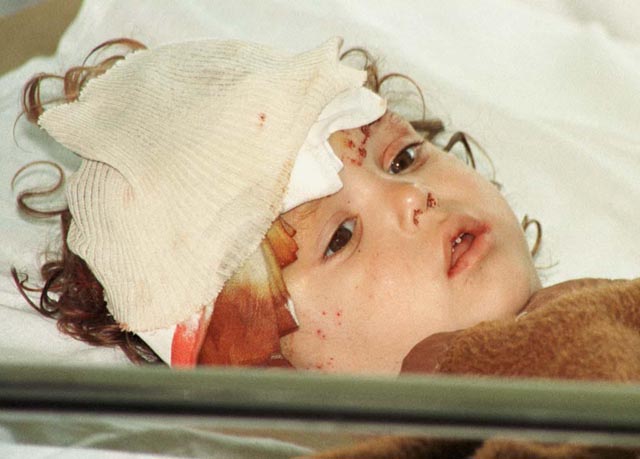
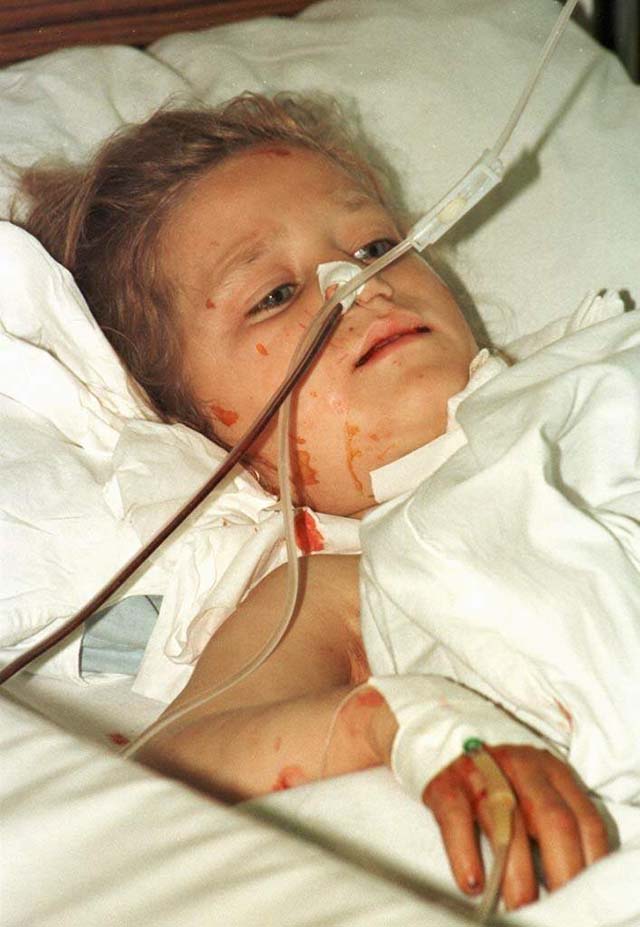
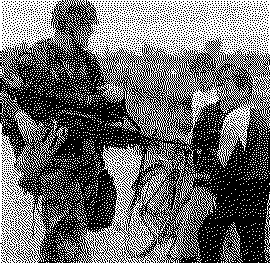
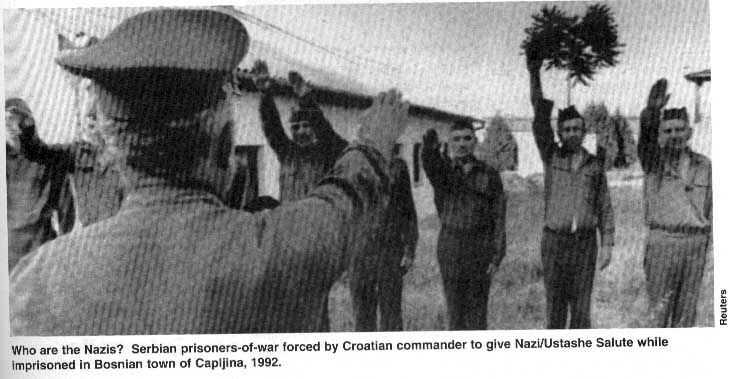
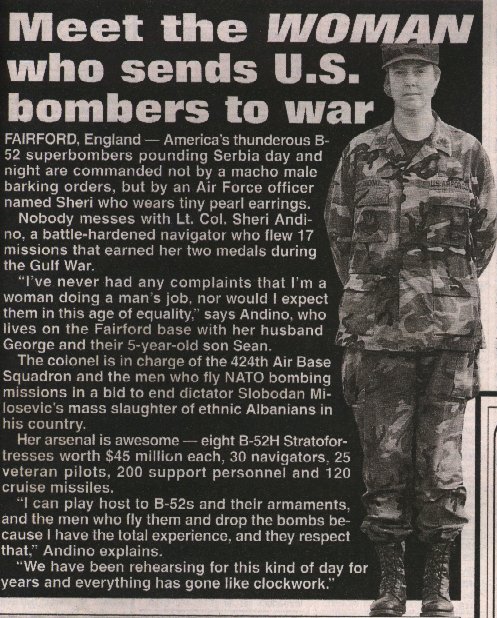
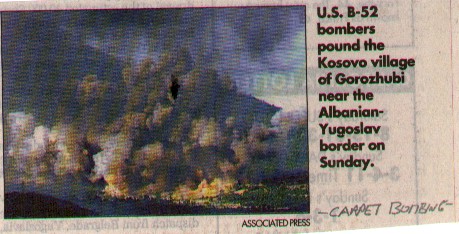
Example of B-52 Carpet Bombing of Yugoslavian Civilians
[Image]
COGHILL RESEARCH LABORATORIES
LOWER RACE, PONTYPOOL, GWENT NP4 5UH
Tel: 00 44 1495 763389 Fax: 00 44 1495 769882
e-mail: [email protected] Website: http://www.cogreslab.demon.co.uk
08/04/1999
THE USE OF DEPLETED URANIUM (DU) BULLETS AND BOMBS BY NATO FORCES IN YUGOSLAVIA
The public at large, both in UK and in Yugoslavia, are unaware that 30 mm bullets being fired by A-10 anti-tank aircraft and probably all Tomahawk Cruise missiles in this action contain depleted uranium (DU).
The development of these radioactive weapons is based on the fact that uranium (atomic mass 238) is much denser than lead (atomic mass 207), and therefore its kinetic energy is sufficient to penetrate tank armour or concrete buildings more effectively than lead, prior to detonation. The design of the bullet is to incorporate a long thin cylinder of DU housed in a plastic sheath or "sabot". This means in turn that the very small leading edge of the bullet peirces with maximum impact. The same principle is used in Tomahawk Cruise missiles, with the aim of piercing concrete obstructions rather than metal.
The bullets were used in the Gulf War , and some 1 million of them still lie in the deserts of that region where subsequently the incidence of leukaemias, cancer, and birth defects have risen sharply as a consequence of the ensuing environmental radiation. The amount of DU scattered around the Gulf war zone is given as 350 tonnes, but including the nose cones of Cruise missiles and helicopter rotors, the figure is nearer 750 tonnes. This is 27 TBequerels of radioactivity, one fiftieth of the total alpha releases from Sellafield over its entire operating history. The same is happening in Bosnia where DU was also employed. Some 80,000 US Gulf War veterans now suffer from the so-called Gulf War syndrome, whose symptoms are identical to radiation sickness. The US military are well aware of this and are on record as confirming 2.5mGy/hr at the surface of a DU shell, a dose equivalent to a chest X-ray per hour. Each A-10 Thunderbolt 30mm cannon anti tank shell contains some 275g (10.1 Bq). A single 120mm Abrams tank DU shell contains 3kg of U-238 (111 MBq) of activity.
When DU bombs detonate, uranium oxide is formed in particulates of between 0.5 and 5 microns. These can be windborne several hundred miles or suspended electrostatically in the atmosphere. The half life of Uranium is 109 (ten to the ninth) years, so they do not decay. One "hot particle" of this DU material in the lungs is equivalent to a chest X-ray per hour for life. It is impossible to remove, so the donated lung gradually irradiates the victim until death ensues. In the use of DU both ground-based combatants and their targets are almost certain to suffer long term radiation sickness and premature death. The Pentagon view is that the short term effectiveness outweighs the long term situation, but this is in error.
The public at large are unaware that these weapons are weapons of mass destruction and have been requested to be placed, like cluster bombs, on the Geneva Convention banned list.
It is said that the unprecedented use of Cruise missiles with DU inserts in Yugoslavia will have the same effect as the Chernobyl and Mile Island disaster. Again these calculations by eminent radiation physicists are not being released to the media. In other words the action of NATO not only In this respect but also, since they have no UN mandate, are illegal, and likely to have a long term pernicious effect not only on that part of Europe, but on their own ground troops if deployed, and almost certainly on the refugees from the Kosovo region. This may be partly why NATO is reluctant to engage ground troops: You will see they are beginning already to wear submicron gas masks on the CNN and other news program pictures.
The Yugoslav population however, together with aid workers and ethnic Albanians are largely unprotected.
Appendix: Metal of Dishonor, 1997.
Did the Pentagon poison Iraq's people and U.S. Soldiers with radioactive weapons? Learn about the criminal use of depleted uranium. Scientists, Gulf War veterans, leaders of environmental, anti-nuclear, anti-military and community movements discuss: a new generation of radioactive conventional weapons; the connections of Depleted Uranium to Gulf War Syndrome; the Pentagon recycling of nuclear waste--a new global threat; and an international movement to BAN all DU weapons.
In May, 1997, the International Action Center published a book of essays and lectures on depleted uranium: the contamination of the planet by the United States military. In addition to exposing the deadly duplicity of the Department of Defense, the book documents the genocide of Native Americans and Iraqis by military radiation, the connection between depleted uranium and Gulf War Syndrome, the underestimated dangers from low-level radiation, the legal ramifications of DU Production and Use, and the growing movement against DU.
Excerpted from Metal of Dishonor : How Depleted Uranium Penetrates Steel, Radiates People and Contaminates the Environment by Ramsey Clark, Helen Caldicott, Michio Kaku, and Jay Gould. Copyright © 1997. Reprinted by permission. All rights reserved
Preface Metal of Dishonor grew out of the work of the Depleted Uranium Education Project and the other organizations that contributed to building a meeting at the United Nations Church Center in New York on September 12, 1996. Hundreds of individuals have made Metal of Dishonor and the entire Depleted Uranium Education Project possible.
Their contributions document the hazardous, radioactive nature of depleted uranium weapons. Scientific papers, scholarly briefs, and forceful arguments-some based on talks given at the September 12 meeting-make up the articles in this book. Scientists, medical and legal experts, political analysts and community activists wrote them. This heterogeneous collection of articles, most published here for the first time, makes a strong case that depleted-uranium weapons are not only lethal to their intended targets, they are dangerous for the humans who handle them and for the present and future environment of the planet. They also show there is potential for building a movement to end this danger.
On February 27, 1997, the Pentagon admitted that eight days of logs documenting chemical exposure have "disappeared." These logs were stored on disc and hard copy in different places. This monumental slip raises these questions: How much other information has also disappeared or been suppressed? Is an even larger coverup taking place? Is something vital about DU also being covered up? We have not yet found data that enumerate how many women, poor people, how many African American, Latino and other people of color suffer from Gulf War Syndrome. But we know that youth in Black, Latino and other communities that face racism are disproportionately pushed into the military by lack of economic opportunity in U.S. society.
Almost half the troops in the Gulf were Black and Latino. The largest number of women in military history served in the Gulf War. It is routine for both the military and the government to ignore these sectors of society regarding benefits and care. It is also that part of the population most likely to need government benefits to get any health care. We have gathered material to explain the impact of uranium mining and waste on Native American lands, the impact on peoples of the South Pacific and U.S. veterans exposed to nuclear blast sites, the impact on peoples living near nuclear reactors and the impact on peoples in the Middle East. Further research in all of these areas is needed along with research on the health and environmental consequences in areas surrounding military test sites and production facilities. Although some of the articles in Metal of Dishonor cover more than one subject, we've grouped them all in specific sections based on a major subject covered. For the convenience of the reader, we've published the more important quotes from government sources in Appendix I. And we have included a section on organizations and resources in Appendix VII that should make it easy for anyone motivated by reading this book to connect with the groups that are carrying out the struggle against DU.
We hope Metal of Dishonor will serve as an organizing tool that will contribute to the fight for an independent inquiry into the causes of Gulf War Syndrome and an eventual ban on the use of depleted-uranium weapons.
Excerpt: Foreword
What Government Documents Admit
"If DU enters the body, it has the potential to generate significant medical consequences. The risks associated with DU in the body are both chemical and radiological."
"Personnel inside or near vehicles struck by DU penetrators could receive significant internal exposures."
From the Army Environmental Policy Institute (AEPI), Health and Environmental Consequences of Depleted Uranium Use in the U.S. Army, June 1995
"Short-term effects of high doses can result in death, while long-term effects of low doses have been implicated in cancer."
"Aerosol DU exposures to soldiers on the battlefield could be significant with potential radiological and toxicological effects."
From the Science Applications International Corporation (SAIC) report, included as Appendix D of AMMCOM's Kinetic Energy Penetrator Long Term Strategy Study, Danesi, July 1990.
This report was completed six months before Desert Storm.
"Inhaled insoluble oxides stay in the lungs longer and pose a potential cancer risk due to radiation. Ingested DU dust can also pose both a radioactive and a toxicity risk."
Operation Desert Storm: Army Not Adequately Prepared to Deal With Depleted Uranium Contamination, United States General Accounting Office (GAO/NSIAD-93-90), January 1993, pp. 17-18.
What the Government Is Telling Us
"The Committee concludes that it is unlikely that health effects reports by Gulf War Veterans today are the result of exposure to depleted uranium during the Gulf war."
From the Final Report: Presidential Advisory Committee of Gulf War Veterans Illnesses, December 1996.
______________________________________________________________________________________________________________________
Columbine
Hitler's Birthday
Every African that could be found was Killed
Klinton Response- "[We have ] to show our children by the power of our own example how to resolve conflicts"
EARTHQUAKE HITS BELGRADE / CHILDREN'S HOSPITAL TARGETED / 300,000+ in city covered by burning oil smoke
An earthquake which measured 5 on the Richter, that is, 7 and 8
on the
Mercali scale shook Belgrade at 5.30 a.m. on Friday.
According to the Serbian seismological institute, the epicenter of the
quake, which was felt almost in the whole of Serbia, was in the Valjevo
region. The first reports say the quake caused no major material damage. At
9.41 a.m. the Serbian Seismological Institute registered yet another quake
which measured 4.7 on the Richter, that is 6 on the Mercali scale. The
renewed tremor was felt in Belgrade and other parts in central Serbia.
The criminal U$ NATO gang is deliberately tearing down factories, schools,
hospitals, bridges and houses, and is trying to cause fear and destroy the
morale of the citizens
A delegation of UNICEF on Friday visited the children's hospital within the
Dragisa Misovic Clinical Medical Centre which suffered considerable damage
in NATO's strikes.
The director of the children's hospital, Dr Zorica Zivkovic, told the
delegation members that there were 14 children aged between 8 months and 3
years at the hospital at the moment, whereas there were 15 babies
The TV transmission tower on Mt Avala, one of Belgrade's symbols, destroyed
in an overnight attack by the Nato aggressors, represented an architectural
masterpiece because of which it has a special protection status.
The 195m-high tower on Mt Avala was built in 1965 according to a project by
Ugljesa Bogunovic, Slobodan Janic and engineer Milan Krstic.
Lives of 300,000 plus endangered by thick, black, smoke covering city from
gasoline refinery,
http://www.beograd.com/radioyu/
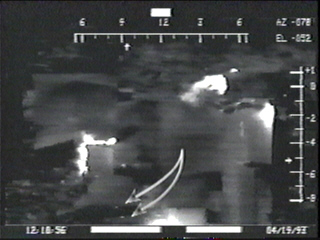
u.$. Military Machine Gun cover for Penetrate & Destroy Mission against Gassed Women and Children in storage room..
Tank is crushing bodies of men defending group (Their bones disabled tank treads.) while Machine Gunners are Massacering Women and Children.trying to escape from incendiary missles.
WACO: The Rules of Engagement - Home Page
POSITIONS AND COMMENTS
of the Government of the Federal Republic of Yugoslavia concerning the OSCE
Report "Kosovo/Kossova As Seen, As Told" on the situation of human rights
in Kosovo and Metohija in the period from October 1998 to October 1999
After careful examination of the OSCE/ODIHR Report "Kosovo/Kossova As
Seen, As Told", Parts I and II, on the human rights situation in Kosovo and
Metohija from October 1998 to October 1999, certain questions inevitably
arise, questions that have not been answered by its authors. There is,
first of all, the question of the purpose and justification of resorting to
an armed aggression against a sovereign country, in violation of all norms
and principles of international law, and secondly the question of the
respect for the fundamental principles of the OSCE.
OSCE reports have received great attention in the world public and media
and have again raised serious doubts as to the reasons and consequences of
the NATO aggression as well as to the real record of performance of the
international administration and the military presence in Kosovo and
Metohija. The Federal Government considers that the data cited and the
methodology used in collecting and presenting information need a critical
analysis and evaluation, both from the point of view of the truthfulness of
the statements and data presented and the method of selecting them, but
also from the point of view of the (political) effects wanted to be
achieved by them.
A one-sided presentation of facts in the report, which does not at all
make use or mention of the findings of the authorities in the FR of
Yugoslavia regarding events that are being reported on, represents an
attempt at justifying the NATO aggression against the FR of Yugoslavia
after the event. The very publication of the report by the OSCE represents
an abuse of that organization already instrumentalized for political
purposes, for the second time (the KVM presence in Kosovo and Metohija
being used to prepare for the NATO aggression). Such abuse has most
seriously undermined the credibility of OSCE, which may have unforeseeable
consequences on its prestige and possibilities for future activity.
1. Although it was not the intent of the report, it revealed in a
documented fashion that there was no humanitarian crisis in Kosovo and
Metohija before NATO aggression, and that problems in this Serbian province
were at least not that serious to provoke the most brutal interference in
the internal affairs of a sovereign State, a gross violation of its
sovereignty and territorial integrity and disrespect of the basic OSCE
principles.
It is clear from the report that prior to NATO aggression there was no
violence against Albanians in Kosovo and Metohija (except actions against
the terrorists of the so-called KLA). These actions of "the army and
paramilitary units were confined to the areas where the so-called KLA had
its bases". It is also clear from the report that the activities of the
Yugoslav authorities in Kosovo and Metohija were directed against a
terrorist and separatist organization which openly advocated "an armed
struggle until liberation". It documented illegal activities carried out by
Albanian separatists (establishment of parallel institutions and
administration, boycotting of elections and the establishment of the
so-called KLA which is being described as "a paramilitary group of Kosovo
Albanians whose purpose is separatism through armed struggle").
Consequently, legitimate reactions of the authorities in the Province
against terrorist and separatist activities cannot be described as
"repression against the Albanian population". The assertion is not true,
either, that "human rights violations were the cause and effect of
conflicts in Kosovo and Metohija", because it was well-documented that the
terrorist activities of the so-called KLA commanded appropriate legitimate
response of the authorities, aimed at their suppression.
The cited information clearly proves that the tragic plight of the Kosovo
population followed "the NATO humanitarian intervention", i.e. the armed
aggression against the FR of Yugoslavia, in which thousands of people were
killed and there was a mass exodus of the population fleeing the bombs. In
other words, the "military intervention" was directly responsible for the
wave of the ethnic cleansing. Instead of being prevented it is going on to
the present day in the presence of UNMIK and KFOR.
2. The relevant authorities of the FR of Yugoslavia kept the international
public and the OSCE Chairman-in-Office regularly informed of the illegal
actions by terrorists and separatists in Kosovo and Metohija (See the set
of documents delivered to the CiO, Mr. Knut Vollebaek, Norwegian Foreign
Minister, on 1 March 1999.).
The terrorist actions of Albanian separatists in Kosovo and Metohija,
prior to the consent of the FRY to accept an OSCE Mission in its territory
as a sign of its good will, had assumed such proportions that they required
energetic measures by the authorities. In a one-year period, from 1
January-31 December 1998 alone, in Kosovo and Metohija there were :
- more than 1,885 terrorist attacks, in which 288 persons were killed and
561 wounded;
- 1,129 terrorist attacks against police personnel and facilities, which
left 115 police officers dead and 403 wounded;
- the remaining 756 attacks were made against civilians, with 173 people
killed and 158 injured.
- During the same period, 308 persons (293 civilians and 15 policemen)
were abducted. Of this number 31 civilians and 3 policemen were killed,
while 143 abducted civilians and 9 policemen are still unaccounted-for.
Following the deployment of OSCE verifiers to Kosovo and Metohija,
terrorist activities did not cease. Only in the period from 13 October 1998
-20 March 1999 (after the agreement reached by the President of the FRY S.
Milo{evi} and US Special Representative Ambassador R. Holbrooke), a series
of terrorist attacks, murders and abductions took place in the presence of
KVM, namely:
- 1,048 attacks (371 against civilians and 677 against police);
- 154 people (127 civilians and 27 policemen) were killed;
- 148 (81 civilians and 67 police officers) sustained serious injuries;
- 100 persons (93 civilians and 7 police officers) were kidnapped (16
killed:14 civilians and 2 policemen and the fate of 37 civilians and 4
policemen is yet unknown);
- 56 terrorist attacks on VJ forces (2 soldiers killed, 9 seriously and 21
slightly injured).
3. Since its deployment in Kosovo and Metohija in October 1998, the OSCE
Kosovo Verification Mission openly defended the separatist movement and the
terrorist KLA there and adopted a benignant and uncritical attitude towards
it. This is evidently the reason why the above information was left out of
the report, because it will clearly show that there was an increase in
terrorist actions during the presence of KVM; that roadblocks were set up
hindering freedom of movement; that kidnappings and arms smuggling were
frequent occurrences. Moreover, strategically important facilities were
marked in this period. In this way, the OSCE and its Mission were grossly
abused and they played a role contrary to the goals of this Organization.
The report singles out, as the most glaring illustration of the alleged
repressive policies of the government before the aggression, the previously
overmagnified and overexploited "events" in the media in the villages of
Ra~ak, Rakovina and Rogovo (that are referred to as "executions"). In these
villages, according to the report, there were mass killings of "Kosovo
Albanians by the Yugoslav/Serbian forces". The report made by the team of
independent forensic experts did not confirm the accusations levelled by
KVM Head W. Walker.
The evidence of the crimes that had allegedly been committed in Kosovo and
Metohija before the aggression, was taken as "eye-witness" statements from
refugees in camps in Albania and Macedonia. In view of the fact that this
part of the report contains most serious accusations levelled at the
actions taken by "police, paramilitary and the military" against the
civilian population - mostly those of Albanian nationality - (torture,
rape, missing persons, arbitrary detention, wanton destruction of property
and looting, use of civilians as human shields, forced expulsions, etc.),
it would be logical that it also contains findings of Yugoslav authorities
concerning the events in question, considering that they were timely
presented and submitted to KVM. Instead, the drafters of the report have
confined themselves to "interviewing eye-witnesses on the ground" and
making public their statements as testimonies of "witnesses for the
prosecution", thus ignoring the reports of the legitimate authorities, a
fact which is both essentially and methodologically unacceptable and cannot
help get an objective picture of events.
4. One may rightfully raise the question of the credibility of the
so-called "evidence of the crimes" committed by police, VJ and paramilitary
forces in the period during the aggression, from 24 March to 9 June 1999,
since KVM withdrew from Kosovo and Metohija on 20 March 1999, i.e. before
the onset of the aggression and was not present there while it was on.
It should be noted that the report did not at all keep track of the crimes
committed by the NATO alliance in Kosovo and Metohija in that period,
although they were widely reported in international media and
well-documented by the competent Yugoslav authorities (See the White Paper,
Part I and II).
The list of crimes and irreparable losses caused by the aggression is
endless:
- More than 2,000 civilians died. This figure is not final given that the
identification of all victims has not been completed;
- More than 7,000 people were wounded and in most cases they will remain
permanently disabled;
- Eighty-two bridges were damaged or destroyed;
- 422 school facilities (school buildings, university colleges, student
dormitories, etc.) were knocked down or damaged;
- 48 health institutions (hospitals, out-patient clinics, health stations,
etc.) were damaged or destroyed;
- 74 TV transmitter, relay and repeater sites were demolished or destroyed;
- Essential infrastructure (power plants, transformer yards, power
distribution system, oil installations, numerous factories, traffic routes,
etc.) were destroyed or severely damaged, as well as great many other
civilian facilities (See the White Paper);
- Over 2.5 million citizens of the FR of Yugoslavia have remained without
the basic means of subsistence;
- Total material losses due to the aggression amount close to US$ 100
billion.
- Total quantifiable losses (due to the sanctions imposed by the
international community, due to the secession of the republics of the
former SFR of Yugoslavia as well as those due to the NATO aggression) in
the period 1991-2010 have been estimated at US$ 200 billion. It is worth
noting that the sanctions, as a flagrant violation of the basic human
rights, have not been devoted any attention in the OSCE report.
Negative effects on the overall development of the FR of Yugoslavia and
the standard of living of its population will be felt for decades to come.
5. Regrettably, the OSCE report does not at all deal with the consequences
of the aggression on the enjoyment of fundamental human rights of the
entire population of the FR of Yugoslavia. Contrary to NATO's propaganda
machine, which sought to create a picture of mass human rights violations
and vulnerability of the Albanian population in Kosovo and Metohija prior
to NATO aggression, the report, nevertheless, clearly indicates that
following the start of "air strikes", there was chaos, uncertainty and fear
(of the bombing) and the population fled in massive numbers, which is
something that the Yugoslav authorities cannot, obviously, be blamed for.
Civilian losses inflicted by the NATO aggressors have been completely
marginalized. Even if they are mentioned, they are justified by the
well-known NATO logic of blaming again the Yugoslav authorities for using
"human shields" to protect facilities and equipment. Thus, massive deaths
among the Albanian civilian population, references to which could not be
avoided, were also blamed on the "Serbian forces" and not attributed to the
fact that this was the region where the largest number of bombs had been
dropped since the end of the Second World War. During the aggression
against the FR of Yugoslavia:
- 35,000 sorties were conducted, involving more than 1,000 aircraft and
206 helicopters;
- More than 10,000 cruise missiles were launched;
- 79,000 tons of ordnance (156 cluster bombs containing 37,440 bomblets).
The report makes no mention of the documentary evidence on the aerial
bombardment nor material losses caused by it. There are no photographs,
either, of the aftermath of the strikes and we are talking here about the
proportionately most bombed region in the history of warfare. Even the
published photographs are not authentic, as evidenced by the bombing of the
"Prizren League" building, which was struck down in the aggressors' attack
on 28 March 1999 (White Paper, p.p. 227 and 228). The report wrongfully
pointed out that the building was "destroyed by the Yugoslav security
forces in March 1999" (Report, p. 334). Such examples make all other cited
information seen in a relatively different light whose credibility may be
brought into question.
Consequently, the OSCE report, which would otherwise make NATO responsible
for the serious crimes against civilians and for breaches of the Geneva
Conventions, was grossly abused as a tool to justify the aggression. Its
purposes were even defined in NATO language ("preventing Yugoslav military
and security forces from continuing repression of civilians and deterring
their further military actions against their own population"), in
contravention of all OSCE principles which were not referred to therein.
Rather than condemning NATO aggression, the report deliberately omitted
any references to it, using the NATO terms for it such as "intervention",
"bombing" or "air strikes" or "air campaign". Most often,
only certain
dates (before or after 24 March 1999) are mentioned, thus suggesting that
the brutal murders of the civilian population and massive destruction of
civilian facilities are the result of the same "repressive policy"
continued by other means. An impression may be gained, therefore, that NATO
bombs killed no one (but they actually killed 2,000 people) and that
Serbian security forces were responsible for all casualties during the "air
strikes", which was why they were targeted by NATO.
The report also lacks what UNMIK and KFOR obviously do not want to talk
about, and that is a politically devastating record of the war, because
this region is now less secure than it used to be; the ethnic cleansing is
going unhampered and local administration is not functioning.
After UNMIK and KFOR took responsibility, massive human rights abuses by
Albanian terrorists and terrorist gangs take place, which is extremely
worrying. Between 10 June 1999 and 6 February 2000 alone, in their presence,
- a total of 4,249 terrorist attacks were made;
- of this number 4,030 were against Serbs and Montenegrins;
- and 126 against other ethnic communities;
- 93 against Albanians;
- 889 persons were killed;
- 784 persons were wounded;
- 834 were abducted and missing (75 killed, 6 escaped, 31 released, 722
still unaccounted-for);
- more than 350,000 were expelled;
- more than 50,000 homes were burned down; and
- over 80 churches and monasteries were demolished.
At the same time, more than 200,000 criminals and looters from
neighbouring Albania were allowed to enter this Serbian province illegally
(See the Memorandum of the FRY Government of 3 November 1999).
7. Despite its efforts to prove the contrary, the OSCE cannot conceal an
evident conclusion that the tragic plight of the Kosovo population is a
direct consequence of the NATO aggression; that thousands of people were
killed during the aggression and not before it; and that an unimpeded
ethnic cleansing of the Province of its Serbs, Roma, Muslims, Turks,
Goranci and other non-Albanians is now under way, in the presence of UNMIK
and KFOR.
While the report blames the Yugoslav authorities for all problems in the
past, it is clear that no one bears responsibility for the current
situation there, characterized by a climate of impunity. Terror, ethnic
cleansing, organized international crime, drug and arms trafficking, human
smuggling, money laundering, abuse of humanitarian aid, etc. continue.
Concurrently, there is a lack of action to prevent such crimes, the lack of
an effective system of protection of the population as well as of the
functioning of local administration. The report does not point, as it has
done in Part I, to the responsibility of office holders in Kosovo and
Metohija (i.e. UNMIK and KFOR) or blames them for the present situation. As
a result, there is a continuing spiral of crime; an ineffective protection
of the basic human rights of non-Albanians and non-functioning local
government. In this part, the report only takes note of human rights
violations (ranging from murders to expulsions, harassment, intimidation,
arson and looting).
The report reveals a number of problems arising out of inoperation of the
military and civilian missions in Kosovo and Metohija, notably
non-fulfilment of the mandate under UN Security Council resolution 1244
(1999). Instead of taking energetic steps and applying existing laws of the
Republic of Serbia and those of the FR of Yugoslavia, UNMIK reacts by
issuing appeals, statements and regulations that are not either enforced or
are not in conformity with the above-mentioned resolution. The lack of
vigorous action by the relevant representatives of the international
community makes them accomplices in the crime of ethnic cleansing that is
under way. The conclusion to be drawn is that the only thing that members
of the international community are seriously concerned for is their own
safety and security.
Part II of the report, covering the period following the take-over of
responsibility by UNMIK and KFOR, may lead to the conclusion that the
current violence against Serbs is massive and systematic in all parts of
Kosovo and Metohija, apparently with the intent to scare off the
non-Albanian population and create a mono-ethnic Kosovo and Metohija. The
key elements of UNMIK's and KFOR's mandates, as defined in Security Council
resolution 1244 (1999), have not been implemented, i.e. to create a secure
environment in which all refugees and displaced persons can return home in
safety, to ensure conditions for a peaceful and normal life for all
inhabitants of Kosovo and Metohija, to maintain a multi-ethnic and
multi-confessional character of the Province, as well as to demilitarize
the so-called KLA. KFOR and UNMIK have failed to ensure free movement in
Kosovo and Metohija and also, with their tolerant attitude towards the
terror of the so-called KLA, are accessory to the blockading and
ghettoization of segments of the Serbian and other non-Albanian populations
herded into several enclaves in Kosovo and Metohija (Orahovac, Gora`devac,
Kosovo Polje). The report failed to point to the responsibility of those
who have undertaken to establish law and order and guarantee security for
all citizens. They will not take the consequences for such failure, either.
Thus, the recognition that UNMIK has been incompetent (or unwilling) to
halt the final stages of the ethnic cleansing in Kosovo and Metohija and to
establish civil administration, is revealed in all its devastating
brutality.
Belgrade, 7 February 2000
___________________________________________________________________________________________________
YUGOSLAV DAILY SURVEY (Morning edition) BELGRADE, 10 February 2000
No. 2886 Kapitalist Chain of Organised Terrorism Orchestrated from
Abroad
[Kapitalist Mafia Members Machine Gun Yugoslav Military Leader in Back while
he is at Restaurant] / Espionage activity of CARE workers in Yugoslavia
Confirmed. / Finnish KFOR troops let Bus be Attacked by CIA
Thugs. /
Etc.
Anti-Worker Thug Contract Agency, CIA, Opens Mortar Attack on Yugoslavian
Village, CIA Kosovo and Metohija Anti-Worker Mafia has taken control of the running
of the drug smuggling channels and drug distribution in the Balkans and
western Europe; Etc. YUGOSLAV DAILY SURVEY (Morning edition)
BELGRADE,
13 December 1999 No. 2775
KFOR/UNMIC on the Take. Provide Front for CIA Anti-Worker Drug
Mafia
State (Similar to u.$) Etc.
YUGOSLAV DAILY SURVEY (Morning
edition) BELGRADE, 20 December 1999 No. 2789
YUGOSLAV DAILY SURVEY BELGRADE, 4 December 1999 No. 2761
UN & KFOR
look on as u.$ Wallstreet Albanian Nazi's Loot Post Office; 4 National
Express Buses Ambushed; Etc.
YUGOSLAV DAILY SURVEY BELGRADE, 24 December 1999 No. 2798
U.N. &
Other International Kapitalist Gangs Attempt to Steal Trepca Metallurgical
Works. Use 'ethnic Albanians' to heist Stari Trg Mine.
Montenegrin
Foreign Minister is Italian Mafia Cigarette Kapo. Etc.
___________________________________________________________________________________________________
FEDERAL REPUBLIC OF YUGOSLAVIA
FEDERAL MINISTRY FOR FOREIGN AFFAIRS
ECONOMIC SURVEY
Belgrade, 10 November 1999 No. 2
INFORMATION ON THE CONSEQUENCES OF NATO AGGRESSION
IN THE FIELD OF HEALTH CARE AND PROTECTION
1. Since the end of the war operations (24 March through 7 June 1999),
according to still incomplete information gathered and processed so far,
more than 1,800 killed and 5,000 wounded persons have been registered,
mostly women, children, the elderly as well as persons belonging to other
vulnerable groups. Some 2,000 wounded persons will remain disabled for life.
2. In the same period, 147 health care institutions were demolished or
damaged along with their equipment, medicines and medical supplies. Special
commissions are in the process of assessing precise financial losses in
each of these institutions, which will be made public once the procedure is
over (Annex: List of health institutions damaged by war operations).
In the wake of NATO bombing, many residents of all nationalities and
religions had to leave their homes and places of residence which negatively
affected regular obligatory immunization (vaccines) against contagious
diseases, the consequences of which are yet to be felt.
Also affected or prevented were:
- regular haematolyses for 4,500 patients affected by chronical terminal
kidney failure, whose lives are directly endangered without this kind of
protection;
- internal, surgical and radiological diagnosis and therapy for 90,000
patients suffering from malignant diseases, which will inevitably increase
the mortality rate related to this disease;
- diagnostics and necessary therapy which will increase the mortality rate
related to the following non-contagious diseases:
200,000 affected by diabetes;
300,000 affected by cardio-vascular diseases;
30,00 affected by neuro-psychiatric diseases;
600 haemophiliacs
400 patients with transplants (kidney, etc).
Hygienic and epidemiological control of potable water and food have also
been made difficult which coupled with degradation of springs and damage to
the water supply system (in most towns) including a large number of
residents accommodated in inadequate dwellings, has already resulted in an
increased number of persons affected by contagious respiratory and stomach
diseases.
4. Precarious financial situation in the Republican Institute for
Health-Care has already brought about extremely difficult situation in
terms of supplying medical institutions with medicines and medical
supplies, be they locally supplied or imported. As it was not possible to
provide medical equipment and spare parts to health care institutions in
the Republic of Serbia in good time, most of the equipment in the health
care institutions is old. Health-care institutions in the Republic of
Serbia at this moment lack a large number of necessary medical equipment:
200 dialysis equipment, 500 various types of defibrillators, 220 various
types of ultrasound equipment, 900 types of ECG equipment, 150 reanimation
kits, 50 sets for anaesthesia with automatic pulmonary respiration, 150
cardio-graphs, 150 tables for neonatal reanimation, 150 respiratory
electrical pumps, 150 blood heaters, 200 different types of incubators
(portable, semi-intensive and intensive care), 100 spyro-metres, 200 blood
counting machines, 400 ambulances with stretchers and related equipment and
a large number of other equipment for all levels and types of health
protection.
5) Due to the destruction of oil refineries in the Republic of Serbia, at
this moment, it is necessary to enure the imports of the following
derivatives: 4,098.17 tonnes of petrol; 1,759.17 tonnes of diesel;
46,767.20 tonnes of crude oil; 42,459.9 tonnes oh heating oil; and 3,507.99
tonnes of natural gas, i.e. necessary financial resources amounting to
159,894,218 US Dollars. The shortage of energy resources directly affects
the functioning and provision of services in medical emergencies and many
other medical branches (Annex: Break down of energy requirement for a
four-month period for individual medical institutions).
6) In the FRY market, the share of imported medical supplies accounts for
45.18 per cent. Since the onset of aggressor operations, domestic
production has been in a critical situation in all production processes in
view of the fact that local production is to a large extent dependant on
imported raw materials and precursors. If pharmaceutical industry is to
continue its production and restore its pre-aggression production level, it
is necessary to ensure raw materials, precursors and other spare parts, in
the amount of DM 200,000,000.00.
In order to meet six-month needs of medical institutions in the Republic
of Serbia related to imports of medicines, it is necessary to ensure
35,261,933.35 DM, for disposable medical supplies 29,169,985.18 DM.
Priority should also be given to 6-month supplies for chemical
laboratories, institutes and health protection centres in the territory of
the Republic of Serbia for purchases of chemicals, diagnostic agents,
serums and other disposable items, in the amount of USD 1,992,233.00. In
order to enable normal functioning of health care service in the Republic
of Serbia, it is necessary to ensure the above financial resources as soon
as possible, namely necessary medicines and other medical disposables.
LIST OF HEALTH CARE INSTITUTIONS DAMAGED IN WAR
OPERATIONS IN THE 24 MARCH - 10 JUNE 1999 PERIOD
1. REGION OF NORTHERN BAC
* ZZZZ Subotica
* Health Care Centre Subotica
Out-Patient Health Institution Subotica: Health Care Unit Palic
2. DISTRICT OF CENTRAL BANAT
3. DISTRICT OF NORTHERN BANAT
4. DISTRICT OF SOUTH BANAT
* Health Centre Pancevo
- General Hospital Pancevo
- Out-Patient Health Institution Pancevo
- Health Unit Kacarevo
- Health Unit Vojilovica
* Pharmacy Pancevo
* Specialized Psychiatric Hospital Vrsac
5. DISTRICT OF WESTERN BAC
- Out-Patient Health Institution with Rehabilitation centre Apatin
- Pharmacy in the village of Kupusina
6. DISTRICT OF SOUTHERN BAC
* Out-Patient Health Institution Novi Sad
- Facility in Sremska Kamenica
* Pharmaceutical facility Novi Sad
- Pharmacy in Sremska Kamenica
- Pharmacy Liman in Novi Sad
7. DISTRICT OF SREM
8. CITY OF BELGRADE
* Institute for Neuro-Psychological Diseases "Dr. Laza Lazarevic"
* Institute for Orthopaedic Diseases and Surgeries Banjica
* Institute for Psycho-Physical diseases and Oral Pathology, "Lipovica" unit
* Specialized Hospital for the Prevention and Cure of Cerebral and Vascular
Diseases "St.Sava"
* Pharmaceutical facility Beograd
- Pharmacy "Fruska Gora" in Zemun
- Pharmacy "Miljakovac"
- Pharmacy "Staro sajmiste"
- Pharmacy "Darinka Radovic" in Sremcica
* Out-Patient Health Institution Obrenovac
- Health Care unit in Baric
- Health Care unit in Stubline
* Out-Patient Health Institution in Rakovica
- Health Care unit on Kanarevo Brdo
- Health Care unit on Labudovo Brdo
- Health Care unit in Resnik
- Infirmary in DMB factory
* Out-Patient Health Institution Zemun
- Health Care unit "13.maj" in PKB Zemun
* Out-Patient Health Institution "Dr Simo Milosevic"
- Health Care unit in Sremcica
- Health Care unit in Zeleznik
* Out-Patient Health Institution Savski Venac - Main building
- Health care centre for school children in Vojvode Milenka Street
- VI Health Care station
* Clinical Hospital Centre "Dr Dragisa Misovic"
* Clinical Centre of Serbia
- Institute for Urology
- Institute for Cardio-Vascular diseases
- Central Pharmacy
* Rehabilitation clinic "Dr Miroslav Zotovic"
* Out-Patient Health Institution Zvezdara
* City Institute for Pulmonary Diseases and TBC protection
9. DISTRICT OF MACVA
* Health Care Centre "Dr Laza Lazarevic" Sabac
10. DISTRICT OF KOLUBARA
* Health Care Centre Valjevo
- General Hospital
- Administration Building
- Infirmary in Pricevic (within Out-Patient Health Institution in Valjevo)
* Pharmaceutical facility in Valjevo
- Pharmacy "1. maj"
- Galenical laboratory
11. DANUBIAN DISTRICT
12. DISTRICT OF BRANICEVO
13. DISTRICT OF SUMADIJA
* Clinical Hospital Centre Kragujevac
* Out-Patient Health Institution Kragujevac
* ZZZZR Kragujevac
* IZZZ Kragujevac
14. MORAVIAN DISTRICT
* Health Care Centre Cuprija
- General Hospital in Cuprija
- Out-Patient Health Institution Cuprija
* ZZZZ Cuprija
15. DISTRICT OF BOR
16. DISTRICT OF ZAJECAR
17. DISTRICT OF ZLATIBOR
* Health Care Centre Uzice
- General hospital Uzice
- Out-Patient Health Institution Uzice
* Health Care centre Pozega
- General Hospital Pozega
- Out-Patient Health Institution Pozega
* Institute for thyroid diseases and metabolism Cajetina
* Pharmaceutical facility Uzice
- Pharmacy "Zdravlje"
- Pharmacy "Zdravlje"
18. DISTRICT OF MORAVICA
* Health Care Centre Cacak
- General Hospital Cacak
- Out-Patient Health Institution Lucani
- Health Care unit "Sloboda" (within Out-Patient Health Institution Cacak)
- Health Care unit Mrcajevci (within Out-Patient Health Institution Cacak)
- Infirmary Medjurecje (within Out-Patient Health Institution Ivanjica)
- Infirmary Prilike (within Out-Patient Health Institution Ivanjica)
* Pharmaceutical institution Cacak
- Pharmacy in Lucani
19. DISTRICT OF RASKA
* Health Care Centre Kraljevo
- Health Care unit Bogutovac (within Out-Patient Health Institution Kraljevo)
- Health Care unit Milocaj (within Out-Patient Health Institution Kraljevo)
- Health Care unit Ladjevci (within Out-Patient Health Institution Kraljevo)
- Health Care unit Samaila (within Out-Patient Health Institution Kraljevo)
- Health Care unit Supnja (within Out-Patient Health Institution Raska)
- Infirmary Brvenik - Kopaonik (within Out-Patient Health Institution Raska)
* Health Care Centre Novi Pazar
- Infirmary "Cukovac" (Children's Hospital)
- Infirmary for Occupational Diseases
* Pharmaceutical Centre Kraljevo
- Pharmacy in Novi Pazar
* Specialized hospital Novi Pazar
20. DISTRICT OF RASINA
* Pharmaceutical institution Krusevac
- Pharmacy "Trstenik"
- Pharmacy "14. oktobar"
- Pharmacy "Atanackovic"
21. DISTRICT OF NISAVA
* ZZZZ Students' Clinic Nis
* Out-Patient Health Institution Nis
- Health Care station in Trg JNA 7 Street
- Infirmary for Occupational Diseases
- Infirmary near the Technical University
- Health Care unit "Jastrebac"
* Health Care centre Aleksinac
- General Hospital Aleksinac
- Day Hospital Aleksinac
* Trauma Centre
* Clinical Centre Nis
- Institute for Pathology
22. DISTRICT OF TOPLICA
* Health Care centre Prokuplje
- Out-Patient Health Institution Prokuplje
- Out-Patient Health Institution Kursumlija
- Infirmary in Kursumlijska Banja (within Out-Patient Health Institution
Kursumlija)
23. DISTRICT OF PIROT
24. DISTRICT OF JABLANICA
* Health Care Centre Leskovac
- General Hospital Leskovac
- Out-Patient Health Institution Leskovac
- Out-Patient Health Institution Grdelica
* ZZZZ Leskovac
* Pharmaceutical facility Leskovac
- Pharmacy "Hipokrat"
- Pharmacy "Centrala"
- Pharmacy "Sutjeska"
25. DISTRICT OF PCINJ
* Health Care centre Vranje
- General Hospital Vranje
- Out-Patient Health Institution Vranje
* ZZZZ Vranje
* Health Care Centre Aleksinac
* Out-Patient Health Institution Vladicin Han
* Specialized Hospital Surdulica
26. DISTRICT OF KOSOVO
* Out-Patient Health Institution Pristina
* Pharmaceutical institution Pristina
- Pharmacy 1
- Pharmacy 3
27. DISTRICT OF PEC
* Health care centre Djakovica
- General Hospital Djakovica
- Out-Patient Health Institution Djakovica
28. DISTRICT OF PRIZREN
* Out-Patient Health Institution Dragas
- Health Care station in the municipality of Gora
29. DISTRICT OF KOSOVO/MITROVICA
* Health Care Center Kosovska Mitrovica
- Out-Patient Health Institution Kosovska Mitrovica
- Out-Patient Health Institution Leposavic
- Out-Patient Health Institution Vucitrn
30. KOSOVO/POMORAVLJE DISTRICT
* Health Care centre Gnjilane
- Infirmary in the village of Vrbovac (within Out-Patient Health
Institution Kosovska Vitina)
* Pharmacy in Gnjilane
_____________________________________________
Yugoslav Daily Survey - Special Issues
BELGRADE, 18 January 2000
O V E R V I E W
of terrorist and other acts of violence in the province of Kosovo and
Metohija
since the arrival of KFOR and UNMIK in the period from 12 June 1999 to 13
January 2000
1) Number of terrorist attacks: 3,688
Out of which 3,630 were committed against civilians, i.e. 3,433 against
Serbs and Montenegrins, 87 against Albanians and 110 against members of
other nationalities.
2) Number of abducted and missing persons: 688
Out of whom 656 were civilians, i.e. 598 were Serbs and Montenegrins, 36
Albanians and 22 members of other nationalities.
The fate of 559 abducted civilians is still unknown while 64 were killed.
3) Number of killed persons: 793
Out of whom 772 were civilians, i.e. 684 were Serbs and Montenegrins (22
massacred, 84 mutilated and 5 burned to death), 63 were Albanians and 25
members of other nationalities in Kosovo and Metohija.
4) Number of arbitrarily arrested persons by KFOR:
Serbs accused of allegedly committing "war crimes" are detained in prisons
in Pristina, Prizren, Sojevo near Urosevac, Kosovska Mitrovica, Gnjilane,
Lipljan and Kolokot Banja. They have been arrested only on the ground of
information provided by the Albanians of the so-called "KLA" and a large
number of these persons are detained without any court decision.
5) Number of wounded persons: 611
6) Reported cases of physical assault, harassment and inflicted grave
bodily harm: 416
7) Registered cases of threats: 356
8) Registered number of dwellings broken into and forcibly taken occupancy
of: 776 in Pristina, over 200 in Kosovska Mitrovica, 190 in Gnjilane, 124
in Orahovac, a large number in Kosovo Polje and Lipljan.
9) Ethnic cleansing: Many towns were ethnically cleansed of Serbs and other
non-Albanians. According to available UNHCR data of September 1999, about
220 000 mainly Serbs and Montenegrins were driven out of Kosovo and Metohija.
According to the latest data over 330 000 Serbs, Montenegrins, Roma,
Muslims, Goranci, Turks and other non-Albanians were expelled, of whom 250
000 are Serbs.
10) Registered number of homes burned down: about 50 000 houses were burned
down in Kosovo and Metohija.
11) Registered number of stolen vehicles: over 12 000 vehicles. As a result
of open borders with Macedonia and Albania 250 000 vehicles were brought
into Kosovo and Metohija without payment of customs duties and most of
these vehicles were stolen.
12) Destruction of churches, monasteries and cultural monuments:
About 80 churches, monasteries and other religious buildings and cultural
monuments were burned down or damaged including the following: the Church
of Assumption of Our Lady in Dolac, monastery of St. Marco in Korisa from
1467, monastery of Prophets Kosmo and Damien in Zatociste from 14 century,
the church in Kijev from the 14th century, the Holy Trinity monastery from
the 14th century near Musutiste, monastery Devic built in 1440, church of
St. Paraskeva in Drenik from the 16th century, church of St. Dimitri near
Pec, the Orthodox church in Grmovo near Vitina, church of St. Ilija in
Cegra near Gnjilane, church of Holy Mother in Musutiste from 1315, church
of Prophet Ilija in Bistricin, church of Apostles Peter and Paul in Suva
Reka, monastery of St. Uros in Nerodimlje, monastery of Archangel Gabriel
from the 14th century in Binac, church of the Holy Virgin from the 16th
century in Belo Polje, church of St. John the Baptist in Pecka Banja,
churches in the villages of Naklo, Vucitrn, Petrovac, Urosevac, Podgorce,
Djurakovac, Krusevo, Osojane, Samodreca, Dresna near Klina, Rekovac,
Petric, monastery Dinac near Vitina, Holy Trinity Cathedral in Djakovica.
Places of worship were attacked, desecrated, demolished and burned down.
Clergy were terrorized and prosecuted. More than 150 parish residences were
destroyed or damaged. Over 10 000 icons and other sacred objects were
stolen or destroyed.
The following cultural monuments were damaged and demolished:
- monuments in memory of giants of Serbian and Montenegrin literature Vuk
Karadzic and Petar Petrovic Njegos in the very centre of Pristina;
- monuments in memory of King Uros in Urosevac and King Dusan in Prizren;
- memorial to Prince Lazar in Gnjilane and the memorial to Serbian rulers
from the Nemanjic dynasty in the village of Gornje Nerodimlje.
13) Forced and illegal taking over of public institutions:
- forcible and illegal take-overs of premises and buildings of post
offices, banks, medical institutions, water and power supply systems,
university, elementary and secondary schools, municipal and other
authorities of local administration, local communes, buildings of the
Ministry of the Interior and the Army of Yugoslavia, factories,
enterprises, cooperatives, etc. in Pristina (premises of the Clinical
centre "Pristina" and the health station, the Federal Customs
Administration, the Public Housing Company, Institute for Urban Planning,
the public enterprise "Vodovod", thermal power plant "Kosovo B",
depots and
petrol stations of "Jugopetrol", the share-holding companies
"Kosmet-Pristina", "Kosovo-Trans", the public enterprise
"Energoinvest",
the public enterprise "Auto-Pristina", "Car shock absorbers plant",
"Jugotrans", etc.) as well as in Prizren, Dragas, Podujevo, Lipljan,
Strpci, Kosovska Mitrovica, Kosovo Polje (with the assistance of the
members of KFOR), Djakovica (with the assistance of the members of KFOR).
- by forced and illegal taking over of public enterprises and institutions
over 20 000 employed Serbs, Montenegrins, Roma, Muslims, Goranci, Turks and
other non-Albanians were sacked and replaced exclusively by Albanians, who
are mostly unskilled.
14) Registered armed attacks on villages: Slovinj, Maticane, Orahovac,
Konjuh, Berivojce, Gornja Brnjica, the villages around Kosovska Kamenica:
Grncar, Magila, Ajvalija, all the villages of the Istok-Klina region,
Goracdevac near Pec, Svinjare, Klokot, Novo Brdo, Zjum, Donja and Gornja
Gusterica, Susica, Badavac, Bresje, Vrbovac, Vitina, Cernice, (municipality
of Gnjilane), Dobrusa, Veliko Ropotovo (municipality of Kosovska Kamenica),
Partes (municipality of Gnjilane), Pasjane (municipality of Gnjilane),
Ljestar, Budriga, Dobrotin (municipality of Lipljan), Grncar, Binac,
Ranilug, Silovo, Odovce, Rajanovce, Bosce, Caglavica, Paravolo, Lebane,
Gojbulja, in the following villages in the area of the municipality of
Gora: Brodosvce, Belobrod, Kukavce - frequent attacks against the houses of
Goranci, Muslims and Albanians who are loyal to the FR of Yugoslavia.
All this runs counter to the assertions about the disarming of the
terrorist "KLA".
15) Registered sieges of villages: Gadnje, Orahovac and Velika Hoca
(population lives in a "ghetto"), Koretin, villages around Gnjilane,
Priluzje, Gornja Srbica, Gorazdevac.
16) Armed threats against villages and terror committed on a daily basis
against non-Albanian population: Ugljari, Srpski Babus, Stimlje, Novo Selo,
Bresje, the area around Kosovo Polje, Milosevo (against which the armed
attack was carried out), village of Zebnice (dramatic humanitarian
situation), majority of the mainly Croatian Catholic population who lived
in the villages of Letinice, Vrnez, Vrnavo Kolo and Sasare have moved out,
Drenovac (50 Serbs massacred), village of Cernice (series of incidents in
which members of the US contingent of KFOR maltreated Serbs), Pozaranje,
Gotovusa, Gatnje, Zubin Potok, Veliki Alas, Vrelo and Radevo.
(17) The looted Serb villages from which the residents were forced out:
Muzicani, Slivovo, Orlovic, Dragas, the area around Kosovo Polje, Sofalija,
Livadice, Mirovac, Siriniska zupa, Medregovac, Grace, Zociste, Sofalije,
Dragoljevac, Tomance, Koretin, Lestar, Donja Sipasnica.
(18) Serb neighbourhoods set on fire: Istok, Klina, Donja Lapastica,
Obrandza, Velika Reka, Perane, Lause, the villages around Podujevo, Grace,
Donja Dubica, Zociste, Orahovac, Naklo, Vitomirice, Belo Polje, Kojlovice,
Alos-Toplicane, Krajiste, Rudnik, Donji Strmac, Goles (municipality of
Lipljan), Orlovic (municipality of Pristina), Krpimej and Lausa
(municipality of Podujevo), Muzicane (all Serbian houses burned down),
Zaimovo, Denovac, Lesjane, Gornje and Donje Nerodimlje (all Serbian houses
looted and then burned down), Sinaje (municipality of Istok), Belovac, Mali
Talinovac, Ljubizda, Klobuka (municipality of Kosovska Kamenica).
(19) Towns and residential areas ethnically cleansed of Serbs, Roma,
Muslims, Goranci and other non-Albanians: Prizren, Djakovica, Pec, Srbica,
Podujevo, Vucitrn, Glogovac as well as the villages in the municipality of
Istok: Dzakovo, Osojane, Tuzepom, Kos, Zac, Belica, Krnjine, Maticane,
Kacanik, Stimlje, Kmetovaska Vrbica, surroundings of Urosevac, Slivovo,
Nedakovac, Nevoljane, Vrpica, Ljestar, Zegra (municipality of Gnjilane),
Zitnje, Pozaranje, Grmovo, Drobes, Kabas and Binac (municipality of Vitina).
- The ethnic cleansing has been in its final stages in Pristina (all the
Serbian population has been driven out of the largest residential quarters:
Ulpijana, Sun_ani Breg, Dardanija, Univerzitetsko Naselje), Gnjilane,
Urosevac, Kosovska Mitrovica, Lipljan, Kosovo Polje where 80 per cent of
the Serbian population has been expelled (houses burned down, looted,
property seized from the owners of shops, Albanian terrorists maltreat and
physically abuse Serbs, who refused to sell their houses and move out of
Kosovo and Metohija, before the very eyes of the members of KFOR), Kosovska
Kamenica, area of Vitina and Kosovsko Pomoravlje, as well as in the
villages of Toplicane, Rujice, Magure, Slovinja, Staro Gracko.
20) Registered number of illegal entries of foreign citizens into the
territory of the FR of Yugoslavia (Kosovo and Metohija) without the
necessary papers (visas and registration of stay with the competent
authorities): 677
Over 200 000 foreigners have illegally entered into the Province with the
consent of UNMIK and KFOR. The Government of the FR of Yugoslavia has
officially requested their expulsion.
21) Registered number of criminal acts of illicit trafficking and
possession of goods without appropriate documents:137
22) Registered number of cases of violation of the land security zone by
KFOR 236
* * *
REVIEW
OF TERRORIST AND OTHER ACTS OF VIOLENCE PERPETRATED BY ALBANIAN TERRORISTS
IN THE PROVINCE OF KOSOVO AND METOHIJA SINCE THE DEPLOYMENT OF KFOR AND UNMIK
IN THE PERIOD FROM 12 JUNE 1999 TO 13 JANUARY 2000
Terrorism of Albanian separatists
Total number of terrorist attacks 3,688
1. Civilians 3,630
- Serbs and Montenegrins 3,433
- Albanians 87
- members of other nationalities 110
2. Officials and facilities 58
A. Killed 793
1. Civilians 772
- Serbs and Montenegrins 684
- Albanians 63
- members of other nationalities 25
2. Officials 21
B. Wounded 611
1. Civilians 604
- Serbs and Montenegrins 565
- Albanians 18
- members of other nationalities 21
2. Officials 7
C. Kidnapped and missing 688
1. Civilians
656
- Serbs and Montenegrins 598
- Albanians 36
- members of other nationalities 22
2. Officials 32
Fate of kidnapped and missing
1. Killed 69
2. Escaped 6
3. Unaccounted-for 581
4. Released 32
__________________________________________________________________________________________________
VIOLATIONS OF THE
SECURITY COUNCIL RESOLUTION 1244 (1999)
OVERVIEW
1. Affirmation of the sovereignty and territorial integrity of the FR of
Yugoslavia: United Nations Security Council resolution 1244 (1999)
unambiguously confirms the sovereignty and territorial integrity of the FR
of Yugoslavia in Kosovo and Metohija (preambular para 10; Annex 2 para 8).
The Resolution limits the mandate of the international security (KFOR) and
civilian (UNMIK) presence to the establishment of conditions for an
unimpeded return of all refugees and displaced persons (paras 1 and 5,
Annex 1; paras 1 and 4, Annex 2), safe environment (op. para 9 c),
preservation of the multi-ethnic, multi-confessional and multi-cultural
character of Kosovo and Metohija and of the basic civilian and
administrative functions (operative para 11 b), with a view to ensuring
conditions for a political solution on the basis of the establishment of a
substantial autonomy within the FR of Yugoslavia (operative para 10).
2. Security of citizens: The Government of the FR of Yugoslavia notes with
concern that KFOR and UNMIK have not fulfilled their obligation
to guarantee security to all citizens in Kosovo and Metohija and to ensure
a safe environment for the return of all refugees and internally displaced
persons (op.para 9 c; Annex 1 para 5, Annex 2 para 7).
KFOR and UNMIK, and the UN Secretary-General's Special Representative B.
Kouchner in particular are, since they ignore the mandate they have been
entrusted to and grossly violate UN SC resolution 1244 (1999), directly
responsible for the lawlessness and chaos prevailing in the Province, for
massive crime, usurpation of the State and private property as well as for
terror, killings, abductions and ethnic cleansing of Serb and other
non-Albanian population.
3. Genocide and ethnic cleansing: Since the deployment of KFOR and UNMIK,
on 12 June 1999, more than 350,000 non-Albanians, primarily Serbs,
Montenegrins, as well as Roma, Muslims, Turks, Goranci and others have been
forcibly driven out of the Province. As many as 768 Serbs were killed and
673 abducted. Not a single perpetrator of these serious criminal acts has
been arrested or brought to justice, which clearly demonstrates the
efficiency of UNMIK police and their protective attitude towards Albanian
terrorists. Most of these serious crimes have been committed by the members
of the so-called KLA, later absorbed into the so-called Kosovo Protection
Corps (KPC).
The remaining Serbs in the Province have been subjected to constant
terror and provocation, herded into few enclaves. KFOR and UNMIK lack any
serious willingness and readiness to protect the remaining Serbs and
members of other non-Albanian ethnic groups in Kosovo and Metohija, exposed
to constant terror and pressure to leave the Province, whereby KFOR and
UNMIK became direct accomplices in ethnic cleansing and genocide in the
southern Serb Province. A telling example of this is a several months-old
blockade of Orahovac by Albanian terrorists, who have virtually turned this
town into a first Nazi ghetto in post-war Europe.
4. Destruction of cultural monuments: In their genocidal campaign of
wiping out all Serb heritage, Albanian terrorists so far destroyed or
damaged more than 80 monasteries and churches of the Serb Orthodox Church,
some of which date back to the XII century and represent a part of not only
Serbian but world cultural heritage.
5. Tolerant attitude and support to terrorists: By their tolerant attitude
towards a systematic campaign of ethnic cleansing and genocide against Serb
and other non-Albanian population, KFOR and UNMIK bear sole responsibility
for the violation of the provisions of UN SC resolution 1244 (1999) on the
preservation of a multi-ethnic, multi-confessional and multi-cultural
character of the Province. KFOR and UNMIK's failure to implement UN SC
resolution 1244 (1999) or gross violations thereof, represent the cause of
lawlessness and chaos in the Province.
6. Violation of the UN Security Council mandate: UNSG Special
Representative and Head of UNMIK B. Kouchner with his arbitrary and
unilateral decisions continuously and flagrantly violates the mandate set
out in UN SC resolution 1244 (1999) and related documents. B. Kouchner has
issued 25 regulations so far, all of which have no basis in UN SC
resolution 1244 (1999), and are aimed at severing all ties of the Province
with the Republic of Serbia and the FR of Yugoslavia, i.e. at completely
separating the Province from the constitutional, legal, economic, customs,
monetary and banking system of the FR of Yugoslavia and the Republic of
Serbia, which is in direct contravention of UN SC resolution 1244 (1999)
and related documents, reaffirming the sovereignty and territorial
integrity of the FR of Yugoslavia in Kosovo and Metohija.
Kouchner has illegally seized all legislative, executive and judicial
power in the Province (Regulation 1999/1 of 25 July 1999). By his
regulation 1999/3 of 31 August 1999, he established a separate customs
service. By his regulation 1999/4 of 2 September 1999, Kouchner illegally
transferred monetary functions to local authorities and introduced the
German Mark as a legal tender. With regulations 1999/16 and 1999/17 of 6
November 1999 and regulations 1999/20 and 1999/21 of 15 November 1999, he
introduced a "Central Banking and Payments Authority", i.e. a separate
banking system in Kosovo and Metohija.
- By Kouchner's regulation 1999/5 of 4 September 1999 on an Ad Hoc Court
of Final Appeal, de facto a supreme court of the Province, was actually
established, while regulations 1999/6 and 1999/7 of 7 September 1999
regulated the administration of justice and prosecution in the Province,
favouring Albanians, with a large number of KLA members including among
judges. Disastrous consequences are evident: so far, no terrorist has been
brought to justice or convicted of serious crimes against the Serbs and
other non-Albanian population.
- Entrusting the regulation of the importation, transportation,
distribution and sale of petroleum products regime to illegal local
authorities controlled by KLA, otherwise a prerogative of the State
sovereign rule (regulation 1999/9 of 24 September 1999), constitutes a
gross violation of UN SC resolution 1244 (1999).
- The same situation prevails concerning the control of payments and
services, post and telecommunication services, granting permits for the
establishment of financial institutions and registration of vehicles, all
of which are uniformly regulated in the entire territory of the FR of
Yugoslavia (regulations 1999/11 of 13 October 1999, 1999/12 of 14 October
1999, 1999/13 of 16 October 1999 and 1999/15 of 21 October 1999).
- UNMIK has been illegally issuing personal documents (vital statistics
records, intention to issue personal IDs) to citizens, without the official
FRY State symbols, on the pretext that Albanians would not accept documents
with official symbols of the FR of Yugoslavia and the Republic of Serbia.
The policy of giving in to the Albanians is also in evidence in connection
with the registration of the population.
- The FRY State property has been illegally transferred to foreign legal
persons (taking control of "Beopetrol" and "Jugopetrol" companies,
forcible
seizure of "Beobanka" branch offices, assigning mobile telephone network
service to French "Alcatel").
- By Kouchner's decision, Kosovo and Metohija has been taken out from a
single power supply system of Serbia and the FR of Yugoslavia and connected
with the power supply systems of Albania and Macedonia, grossly violating
the sovereignty and territorial integrity of the FRY.
- By preventing the activities of media outlets in Serbian and forcible
seizure of their premises and equipment, favouring at the same time the
media in Albanian, not only has destroyed a single media system of the FR
of Yugoslavia and Republic of Serbia but encourages discrimination based on
ethnicity, contrary to the basic intentions of the SC Resolution on the
preservation of the multi-ethnic, multi-cultural and multi-confessional
character of the Province.
- Without prior approval of the competent FRY authorities, KFOR and UNMIK
have established international transport between the Province and some
States, including those with which the FR of Yugoslavia does not have
diplomatic relations. The establishment of local air, railway and other
transport between the Province and other parts of the single FRY territory
has been prevented, which is particularly unacceptable.
7. Establishment of illegal organs of administration: By a fait accompli
tactic, without consulting legal representatives of the Republic of Serbia
and the FR of Yugoslavia, Special Representative Kouchner has illegally
established the so- called Interim Administration Council, de facto
provincial "Government", comprised exclusively of Albanians, mostly leaders
of the terrorist so-called KLA and Albanian separatist political parties,
in an attempt to legalise an ethnically pure Kosovo and Metohija, contrary
to UN SC resolution 1244 (1999).
8. Blocking a political settlement: UNMIK and B. Kouchner do not accept
dialogue and co-operation with representatives of the Governments of the FR
of Yugoslavia and the Republic of Serbia on questions of interest for the
stabilisation of the overall security, economic and political situation in
the Province.
The contact between UNMIK and the Government of the FR of Yugoslavia
concerning substantial autonomy and self-government in Kosovo and Metohija
(Resolution op.para 11 a; Annex 1 para 6 and Annex 2 para 5) has not been
established. UNSG Special Representative Kouchner persistently continues to
ignore repeated requests of the Government of the FR of Yugoslavia
addressed to the UN Secretary-General and the Security Council to start
negotiations on substantial autonomy in Kosovo and Metohija (op.para 11 a;
Annex 2 para 8) between the legitimate representatives of the Republic of
Serbia and the FR of Yugoslavia and the representatives of all ethnic
communities in Kosovo and Metohija.
9. Control of the State border: KFOR and UNMIK do not carry out their
obligation to control the State border of the FR of Yugoslavia towards
Albania and Macedonia (op.para 9 g), which is why more than 200,000
foreigners came to the territory of the FRY, including a large number of
the terrorists of the so-called KLA and criminal gangs, especially the
narco-mafia, illegal arms and white slave traders, etc., whereby Kosovo and
Metohija has become the centre for the expansion of organised crime
throughout Europe. Illegal entries to the FR of Yugoslavia have not stopped
despite the assurances by KFOR and UNMIK that they consistently implement
their obligations arising from the Resolution, regarding the safeguarding
of the FRY international border.
10. Return of the Army of Yugoslavia (VJ) and police: The return of the
agreed number of members of VJ and Serb police in Kosovo and Metohija is
still unjustifiably prevented and delayed (Annex 2 para 6), which
additionally encourages Albanian terrorists to continue with their daily
terror against the Serb and other non-Albanian population with a view to
completing the ethnic cleansing of the Province.
11. Demilitarisation and disarming of the so-called KLA: Terrorist so-
called KLA has not been disarmed or demilitarised, which represents one of
the most serious examples of gross violation of UN SC resolution 1244
(1999) (op.para 9 b and op.para 15). Only a token quantity of antiquated
arms were surrendered. Secret arms caches of terrorists are being revealed
every day. The border with Albania and Macedonia has not been closed,
whereby KFOR and UNMIK continue to enable the entry of armed terrorists and
large quantities of arms in the Province. This has been testified to by
daily armed attacks of Albanians on Serb enclaves, buses and other means of
transport carrying Serb and other non-Albanians as well as against their
houses, land and other property.
12. Transformation of the so-called KLA: The establishment of the so-
called Kosovo Protection Corps (KPC), which is made up of members of the
terrorist so-called KLA (in Albanian translation "corps" means
"force"),
has actually legalised this terrorist organisation as well as its former
leadership and enhanced its combat organisational structure. While the
leadership of the so-called KPC has retained a wide authority through
"transformation" - its members publicly carry light weapons and they hide
their heavy weapons in hide-outs whose location is known to KFOR. At the
same time, "KPC" leadership or the former leaders of the terrorist
so-called KLA publicly state that "KPC", as a parallel structure of the
so-called KLA, represents a model for the future "Kosovo Army".
13. Security and freedom of movement for international representatives:
Passive attitude of KFOR and UNMIK towards several-months long Albanian
blockade of the deployment of a Russian KFOR contingent in Orahovac,
confirms their protective stance towards Albanian terrorists and represents
an open violation of UN SC resolution 1244 (1999) on security and freedom
of movement of KFOR and UNMIK, as well as other international organisations
(op.para 9 h).
14. Legal status of the UN peace-keeping mission: Proceeding from the fact
that Kosovo and Metohija is part of the sovereign territory of the FR of
Yugoslavia, the Government of the FR of Yugoslavia, as the host, has
initiated, since the deployment of international security and civilian
presence under the auspices of the United Nations in Kosovo and Metohija,
the conclusion of an appropriate agreement with the United Nations
concerning the legal status of this mission, which did not take place due
to the refusal on the part of the United Nations.
15. Para-diplomatic missions and visits by foreign officials: UNMIK has
allowed the illegal establishment of para-diplomatic missions of some
countries in Kosovo and Metohija, in a gross violation of the principle of
the sovereignty and territorial integrity of the FR of Yugoslavia.
Despite the repeated official protests by the Government of the FR of
Yugoslavia addressed to the Security Council, the Secretary-General and
KFOR and UNMIK, an illegal practice continues of establishing "diplomatic
offices" of foreign States in Kosovo and Metohija, which constitutes a
drastic violation of Security Council resolution 1244 (1999) and Article 2
of the Vienna conventions on diplomatic and consular relations, as well as
a hostile act towards a receiving country whose sovereignty is flagrantly
violated, because it is done without its prior consent.
Ignoring the warnings and overriding the official protests by the FR of
Yugoslavia an unacceptable practice is being continued of not notifying the
visits of foreign officials to Kosovo and Metohija, thus violating the
provisions of SC resolution 1244 (1999) and Annex 2 paras 5 and 8, and the
Vienna Convention on Diplomatic Relations and the existing Yugoslav visa
regime.
The Government of the FR of Yugoslavia insists that this illegal practice
be immediately terminated and that the behaviour of all factors in the
Province be strictly in accordance with the provisions of the Resolution
and the applicable international conventions and practice.
16. Responsibility of KFOR and UNMIK: KFOR and UNMIK are responsible for
disturbing developments in the Province.
By failing to comply with the clear responsibilities under SC resolution
1244 (1999) and the relevant
documents or by interpreting them arbitrarily as well as by an inadmissibly
tolerant attitude towards Albanian terrorists, KFOR and UNMIK bear full
responsibility for the crimes of genocide and systematic ethnic cleansing
that are being perpetrated against Serbs and other non-Albanian population
in their presence, thus using the UN peace-keeping mission as a smoke
screen and actually becoming accomplices in these serious crimes.
17. Responsibility of the UN Security Council: Under SC resolution 1244
(op. paras 19 and 20), the Security Council guarantees its implementation.
In view of the tragic situation in Kosovo and Metohija and systematic
violations of all crucial provisions of UN SC resolution 1244 (1999) and
the Military Technical Agreement, the FR of Yugoslavia demands that the
Security Council undertake without delay most energetic steps and measures
for their consistent implementation and prevent all attempts at departing,
postponing to carry out or arbitrarily interpreting the provisions of this
Resolution.
In that context, the Government of the FR of Yugoslavia energetically
demands that the Security Council rescind, without delay, all illegal
decisions of UNSG Special Representative B. Kouchner and take other
measures, as may be necessary, to have the situation in Kosovo and Metohija
restored to its previous state.
All decisions of KFOR and UNMIK which are contrary to the Resolution and
related documents imply either their gross violation or arbitrary
interpretation, particularly regarding strict respect for the sovereignty
and territorial integrity of the FR of Yugoslavia in the southern Serb
Province, are considered by the Government of the FR of Yugoslavia null and
void and cannot have any legal effect.
Belgrade, 10 January 2000
_______________________________________________________________________